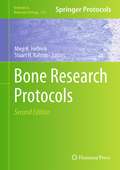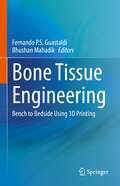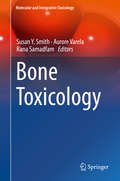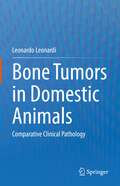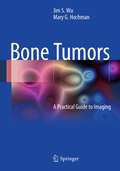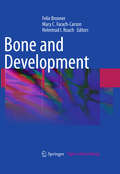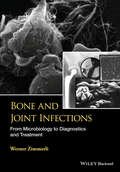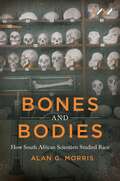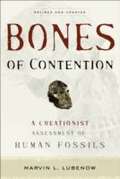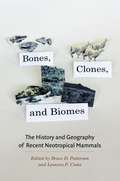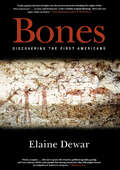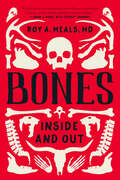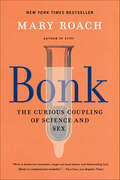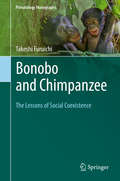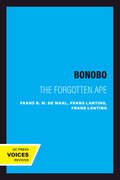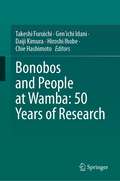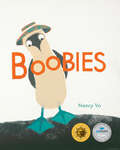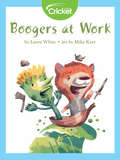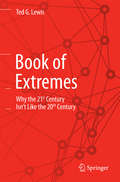- Table View
- List View
Bone Research Protocols, 2nd Edition (Methods in Molecular Biology #816)
by Miep H. Helfrich Stuart H. RalstonStudies over the past decade have continued to bring tremendous advances to our understanding of bone biology. New pathways have been discovered and expanded our knowledge of the ways in which genes and gene products affect bone cells and thereby bone mass and bone strength. In Bone Research Protocols, Second Edition, expert researchers in the field detail many methods commonly used to study bone biology. Focusing mainly on in vitro methods, this volume gives techniques for isolation, culture and functional analysis of all bone cell types and details a range of imaging methods, including light and ultrastructural microscopy and live cell imaging. Some important in vivo techniques are included, such as analysis of bone resorption and imaging using X rays, fluorescent or luminescent techniques. Methods for study of proteins and nucleic acid are included and methods for analysis of bone composition, measurement of bone strength, and response to mechanical stimulation are described. Written in the highly successful Methods in Molecular Biology™ series format, chapters include introductions to their respective topics, lists of the necessary materials and reagents, step-by-step, readily reproducible laboratory protocols, and key tips on troubleshooting and avoiding known pitfalls.<P><P> Authoritative and practical, Bone Research Protocols, Second Edition seeks to aid scientists in the bone field to establish new techniques in their laboratories.
Bone Rooms: From Scientific Racism to Human Prehistory in Museums
by Samuel J. RedmanIn the bone rooms of the Smithsonian Institution and other museums in the late nineteenth century, a scientific revolution was unfolding, as collectors engaged in a global competition to recover the best human skeletons, mummies, fossils. Study of these remains led to the discrediting of racial theory and the search for human origins and evolution.
Bone Tissue Engineering
by Jeffrey O. Hollinger Thomas A. Einhorn Bruce A. Doll Charles SfeirFocusing on bone biology, Bone Tissue Engineering integrates basic sciences with tissue engineering. It includes contributions from world-renowned researchers and clinicians who discuss key topics such as different models and approaches to bone tissue engineering, as well as exciting clinical applications for patients. Divided into four sections, t
Bone Tissue Engineering: Bench to Bedside Using 3D Printing
by Fernando P. S. Guastaldi Bhushan MahadikThis book provides a comprehensive overview of the state-of-the-art research as well as current challenges and strategies to reconstruct large bone defects employing 3D printing technology. Various topics covered include different 3D printing technologies that can be applied for bioengineering bone, the aspects of basic bone biology critical for clinical translation, tissue engineering platforms to investigate the bone niche microenvironment, the pathway to clinical translation, and regulatory hurdles.Bone Tissue Engineering: State-of-the-Art in 3D Printing is an ideal book for students and researchers interested in learning more about the latest advances in employing different 3D printing technologies for bone tissue engineering.
Bone Toxicology (Molecular and Integrative Toxicology)
by Susan Y. Smith Aurore Varela Rana SamadfamThe content of this book is intended to provide the toxicologist in drug development in the pharmaceutical and biotechnology industries with a broad understanding of bone and its interactions with other organ systems in safety assessments. The book is divided into three parts. The first part describes our current understanding of bone biology and its primary regulatory pathways. Additional chapters address regulatory and study design considerations for incorporating bone end points in toxicology studies, with special consideration being given to juvenile toxicology studies. This is intended to address recent regulatory requirements to evaluate skeletal development for drugs in development for pediatric populations. The second part of the book describes the principal techniques and methods used in bone research; understanding how these end-points are derived is fundamental to their appropriate application. These first two parts of the book provide the background and the means to develop the concepts in part three which describes bone and its interaction with other organ systems. The unique series of chapters in part three, contributed to by key leaders in their respective fields and in bone research, provides a comprehensive collective work. Although constantly evolving, the crosstalk and interaction of the skeleton with several organ systems is now recognized and well documented, such as for the reproductive system, muscle and kidney, while our understanding of the interaction with other organ systems, such as the immune system and CNS, is in its infancy. Recent work highlights the key role of the skeleton in the regulation of energy metabolism and the impact this has on research in metabolic diseases such as obesity and diabetes. The hope is that this book will enlighten many and encourage more to explore the impact of new compounds on the skeleton in the development of effective and safe drugs.
Bone Tumors in Domestic Animals: Comparative Clinical Pathology
by Leonardo LeonardiThis book comparatively examines the etiopathogenetic, clinical-pathological, diagnostic and therapeutic strategies of the main bone tumors of domestic animals. The book also includes a description of the most significant aspects of macroscopic, microscopic, immunohistochemical, instrumental, diagnostic imaging and molecular biology aspects of spontaneous bone tumors in Veterinary Medicine, with also interspecies comparative aspects, including the human one. Last but not least, the book provides an overview of the new diagnostic and therapeutic frontiers related to the approach to animal bone tumors. The book serves as essential reading for professionals, researchers and students who work or want to tackle three paths in the field of comparative veterinary bone oncology.
Bone Tumors: A Practical Guide to Imaging
by Jim S. Wu Mary G. HochmanBone Tumors: A Practical Guide to Imaging is a concise guide to common tumors encountered by physicians in daily practice. The authors make use of high-yield facts, differential diagnoses, and extensive radiological images to introduce a wide range of bone tumors, focusing on their classic appearance and location in order to provide readers with a solid foundation of knowledge for tumor recognition and evaluation. The book includes explanations of methods for properly evaluating bone lesions, common imaging modalities used for diagnosis, and individual chapters covering different classes of benign and malignant tumors, including cartilage, osseous, fibrous, miscellaneous, and bone metastases. The book concludes with a comprehensive selection of 75 unknown cases, including brief clinical history, description of imaging findings, best differential diagnoses, and short discussion revealing the most likely diagnosis. Bone Tumors is an ideal resource for practicing physicians and residents in radiology, orthopedic surgery, pathology, and primary care. About the Authors Jim S. Wu, MD, is Assistant Professor of Radiology at Beth Israel Deaconess Medical Center, Harvard Medical School. Mary G. Hochman, MD, is Chief of the Section of Musculoskeletal Imaging and Assistant Professor of Radiology at Beth Israel Deaconess Medical Center, Harvard Medical School.
Bone Yard (Firestormers)
by Carl BowenAs a historic wildfire bears down on a desolate, close-knit community, the FIRESTORMERS the world’s newest, most elite wildfire fighting crew prepare to battle the blaze. Unfortunately, community members would rather die than leave their homes and belongings behind. As tornadoes of fire approach, Firestormer Amalia Rendon must convince citizens to evacuate before their community and everything in it becomes a smoldering bone yard.
Bone and Development (Topics in Bone Biology #6)
by Mary C. Farach-Carson Felix Bronner Helmtrud I. RoachThis is a sixth volume in a series of reviews, centered on a single major topic within the field of osteopathy. The book is an appropriate mechanism for advancing knowledge in the field to researchers, clinicians and others involved in the bone field. This work intends to look at the role bone development within the field of pediatrics, covering all problematic aspects from basic skeletal growth to tooth mineralization. To understand tissue development requires combining embryological and histological knowledge with the increasing information becoming available from molecular and genetic studies. Development is characterized by the expression of genes, their subsequent silencing and the expression of other genes. Disease, especially disease progression, is equally characterized by new gene expression that is then transmitted to daughter cells, with the silencing of other genes. In both instances these sequences are the result of the interaction between the genome and the epigenome, i.e. between a very stable set of structures and rapidly changing environmental factors.
Bone and Joint Infections
by W. ZimmerliBone and Joint Infections is the first book to take a multidisciplinary approach to covering the causes and treatment of osteomyelitis and septic arthritis. Correct and rapid diagnosis of bone and joint infection requires the input of a variety of specialists, and Bone and Joint Infection takes a similarly collaborative and comprehensive approach, including chapters from a diverse group of clinicians, researchers, and surgeons.Covering both the basic microbiology and clinical aspects of bone and joint infection, this book will be a valuable resource both for researchers in the lab and for physicians and surgeons seeking a comprehensive reference on osteomyelitis and septic arthritis.
Bone-Metabolic Functions and Modulators (Topics in Bone Biology #7)
by Mary C. Farach-Carson Felix Bronner Helmtrud I. RoachRecent research, which Bone- Metabolic Function and Modulators expands on, has added new support to the idea that bone not only serves as a support system, but also functions as an integrating organ, with a significant regulatory role for lipid and energy metabolism. Links between physical activity and the skeleton are also becoming increasingly clear. This fully illustrated volume contains up-to-date information on the metabolic role of the skeleton and what this can mean for the treatment of metabolic as well as skeletal and auditory diseases. Bone- Metabolic Function and Modulators is of particular interest to clinician scientists, clinical and basic bone researchers, orthopedists, endocrinologists, internists, dentists, nurse practitioners, medical and dental residents and physiotherapists as well as students of the musculoskeletal system. Bone- Metabolic Function and Modulators is the seventh volume in the series Topics in Bone Biology, edited by Felix Bronner and Mary C. Farach-Carson. Other titles in this series:- Bone Formation Bone Resorption Engineering of Functional Skeletal Tissues Bone and Osteoarthritis Bone and Cancer Bone and Development Bone- Metabolic Function and Modulators is of particular interest to clinician scientists, clinical and basic bone researchers, orthopedists, endocrinologists, internists, dentists, nurse practitioners, medical and dental residents and physiotherapists as well as students of the musculoskeletal system. Bone- Metabolic Function and Modulators is the seventh volume in the series Topics in Bone Biology, edited by Felix Bronner and Mary C. Farach-Carson. Other titles in this series:- Bone Formation Bone Resorption Engineering of Functional Skeletal Tissues Bone and Osteoarthritis Bone and Cancer Bone and Development Bone- Metabolic Function and Modulators is of particular interest to clinician scientists, clinical and basic bone researchers, orthopedists, endocrinologists, internists, dentists, nurse practitioners, medical and dental residents and physiotherapists as well as students of the musculoskeletal system. Bone- Metabolic Function and Modulators is the seventh volume in the series Topics in Bone Biology, edited by Felix Bronner and Mary C. Farach-Carson. Other titles in this series:- Bone Formation Bone Resorption Engineering of Functional Skeletal Tissues Bone and Osteoarthritis Bone and Cancer Bone and Development
Bones and Bodies: How South African Scientists Studied Race
by Alan G MorrisAlan G. Morris critically examines the history of evolutionary anthropology in South Africa, uncovering the often racist philosophical motivations of these physical anthropology researchers and the discipline itselfSouth Africa is famed for its contribution to the study of human evolution. In Bones and Bodies Alan G. Morris takes us back over the past century of anthropological discovery in South Africa and uncovers the stories of the individual scientists and how they contributed to our knowledge of the peoples of southern Africa, both ancient and modern. Not all of this history is one which we should feel comfortable with, as much of the earlier anthropological studies have been tainted with the tarred brush of race science. Morris critically examines the work of Raymond Dart, Thomas Dreyer, Matthew Drennan, and Robert Broom who all described their fossil discoveries with the mirror of racist interpretation, as well as the life and times in which they worked.Morris also considers how modern anthropology tried to rid itself of the stigma of these early racist accounts. In the 1960s and 1970s, Ronald Singer and Phillip Tobias introduced modern methods into the discipline that jettisoned much of what the public wished to believe about race and human evolution. Modern methods in physical anthropology rely on sophisticated mathematics and molecular genetics but are difficult to translate and sometimes fail to challenge preconceived assumptions.In an age where the authority of the expert and empirical science is questioned, this book shows the battle facing modern anthropology in how to explain science in a context that seems to be at odds with life experience. In this highly accessible insider account, Morris examines the philosophical motivations of these researchers and the discipline itself. Much of the material draws on old correspondence and interviews as well as from published resources.
Bones of Contention: A Creationist Assessment of Human Fossils
by Marvin L. LubenowAttending to the exuberance of evolutionists, Marvin L. Lubenow seeks to show that fossils do more to disprove evolutionary theory than otherwise. In Bones of Contention, Lubenow offers scholars and laypeople alike a readable argument for the creationist view of the origins of humankind that addresses all angles of the issue, and answers all of their tough questions. The new edition has thoroughly updated and revised material to reflect years of evolutionist theory and modern paleoanthropology.
Bones, Clones, and Biomes: The History and Geography of Recent Neotropical Mammals
by Bruce D. Patterson and Leonora P. CostaAs explorers and scientists have known for decades, the Neotropics harbor a fantastic array of our planet’s mammalian diversity, from capybaras and capuchins to maned wolves and mouse opossums to sloths and sakis. This biological bounty can be attributed partly to the striking diversity of Neotropical landscapes and climates and partly to a series of continental connections that permitted intermittent faunal exchanges with Africa, Antarctica, Australia, and North America. Thus, to comprehend the development of modern Neotropical mammal faunas requires not only mastery of the Neotropics’ substantial diversity, but also knowledge of mammalian lineages and landscapes dating back to the Mesozoic.Bones, Clones, and Biomes offers just that—an exploration of the development and relationships of the modern mammal fauna through a series of studies that encompass the last 100 million years and both Central and South America. This work serves as a complement to more taxonomically driven works, providing for readers the long geologic and biogeographic contexts that undergird the abundance and diversity of Neotropical mammals. Rather than documenting diversity or distribution, this collection traverses the patterns that the distributions and relationships across mammal species convey, bringing together for the first time geology, paleobiology, systematics, mammalogy, and biogeography. Of critical importance is the book’s utility for current conservation and management programs, part of a rapidly rising conservation paleobiology initiative.
Bones, Genetics, and Behavior of Rhesus Macaques: Macaca Mulatta of Cayo Santiago and Beyond (Developments in Primatology: Progress and Prospects)
by Qian WangForeword by Phillip V. Tobias The introduction of rhesus macaques to Cayo Santiago, Puerto Rico in 1938, and the subsequent development of the CPRC for biomedical research, continues its long history of stimulating studies in physical anthropology. The CPRC monkey colonies, and the precise demographic data on the derived skeletal collection in the Center's Laboratory of Primate Morphology and Genetics (LPMG), provide rare opportunities for morphological, developmental, functional, genetic, and behavioral studies across the life span of rhesus macaques as a species, and as a primate model for humans. The book grows out of a symposium Wang is organizing for the 78th annual meeting of the American Association of Physical Anthropologists to be held in April 2009. This symposium will highlight recent and ongoing research in, or related to, physical anthropology, and reveal the numerous research opportunities that still exist at this unusual rhesus facility. Following an initial historical review of CPRC and its research activities, this book will emphasize recent and current researches on growth, function, genetics, pathology, aging, and behavior, and the impact of these researches on our understanding of rhesus and human morphology, development, genetics, and behavior. Fourteen researchers will present recent and current studies on morphology, genetics, and behavior, with relevance to primate and human growth, health, and evolution. The book will include not only papers presented in the symposium, but also papers from individuals who could not present their work at the meeting due to limitations in the maximum number (14) of permitted speakers.
Bones: Cells at Work (Theme Sets)
by Ralph MitchellBone cells are cells in the body that help the bones exchange minerals with the rest of the body by way of the circulatory system.
Bones: Discovering the First Americans
by Elaine DewarScientists not so long ago unanimously believed that people first walked to the New World from northeast Asia across the Bering land bridge at the end of the Ice Age 11,000 years ago. But in the last ten years, new tools applied to old bones have yielded evidence that tells an entirely different story. In Bones, Elaine Dewar records the ferocious struggle in the scientific world to reshape our views of prehistory. She traveled from the Mackenzie River valley in northern Canada to the arid plains of the Brazilian state of Piaui, from the skull-and-bones-lines offices of the Smithsonian Institution to the basement lab of an archaeologist in Washington State who wondered if the FBI was going to come for him. She met scientists at war with each other and sought to see for herself the oldest human remains on these continents. Along the way, she found that the old answer to the question of who were the First Americans was steeped in the bitter tea of racism. Bones explores the ambiguous terrain left behind when a scientific paradigm is swept away. It tells the stories of the archaeologists, Native American activists, DNA experts and physical anthropologists scrambling for control of ancient bones of Kennewick Man, Spirit Cave, and the oldest one of all, a woman named Luzia. At stake are professional reputations, lucrative grants, fame, vindication, even the reburial of wandering spirits. The weapons? Lawsuits, threats, violence. The battlefield stretches from Chile to Alaska. Dewar tells the stories that never find their way into scientific papers -- stories of mysterious deaths, of the bones of evil shamen and the shadows falling on the lives of scientists who pulled them from the ground. And she asks the new questions arising out of the science of bones and the stories of first peoples: What if Native Americans are right in their belief that they have always been in the Americas and did not migrate to the New World at the end of the Ice Age? What if the New World's human story is as long and complicated as that of the Old? What if the New World and the Old World have always been one?
Bones: Inside And Out
by Roy A. Meals MDA lively, illustrated exploration of the 500-million-year history of bone, a touchstone for understanding vertebrate life and human culture. Human bone is versatile and entirely unique: it repairs itself without scarring, it’s lightweight but responds to stresses, and it’s durable enough to survive for millennia. In Bones, orthopedic surgeon Roy A. Meals explores and extols this amazing material that both supports and records vertebrate life. Inside the body, bone proves itself the world’s best building material. Meals examines the biological makeup of bones; demystifies how they grow, break, and heal; and compares the particulars of human bone to variations throughout the animal kingdom. In engaging and clear prose, he debunks familiar myths—humans don’t have exactly 206 bones—and illustrates common bone diseases, like osteoporosis and arthritis, and their treatments. Along the way, he highlights the medical innovations—from the first X-rays to advanced operative techniques—that enhance our lives and introduces the giants of orthopedic surgery who developed them. After it has supported vertebrate life, bone reveals itself in surprising ways—sometimes hundreds of millions of years later. With enthusiasm and humor, Meals investigates the diverse roles bone has played in human culture throughout history. He highlights allusions to bone in religion and literature, from Adam’s rib to Hamlet’s skull, and uncovers its enduring presence as fossils, technological tools, and musical instruments ranging from the Tibetan thighbone kangling horn to everyday drumsticks. From the dawn of civilization through to the present day, humankind has repurposed bone to serve and protect, and even to teach, amuse, and inspire. Approachable and entertaining, Bones richly illuminates our bodies’ essential framework.
Bonk: The Curious Coupling of Science and Sex
by Mary RoachA New York Times Bestseller "Rich in dexterous innuendo, laugh-out-loud humor and illuminating fact. It’s compulsively readable." —Los Angeles Times Book ReviewIn Bonk, the best-selling author of Stiff turns her outrageous curiosity and insight on the most alluring scientific subject of all: sex. Can a person think herself to orgasm? Why doesn't Viagra help women—or, for that matter, pandas? Can a dead man get an erection? Is vaginal orgasm a myth? Mary Roach shows us how and why sexual arousal and orgasm—two of the most complex, delightful, and amazing scientific phenomena on earth—can be so hard to achieve and what science is doing to make the bedroom a more satisfying place.
Bonobo and Chimpanzee: The Lessons of Social Coexistence (Primatology Monographs)
by Takeshi FuruichiThis book describes the similarities and differences between two species, bonobos and chimpanzees, based on the three decades the author has spent studying them in the wild, and shows how the contrasting nature of these two species is also reflected in human nature. The most important differences between bonobos and chimpanzees, our closest relatives, are the social mechanisms of coexistence in group life. Chimpanzees are known as a fairly despotic species in which the males exclusively dominate over the females, and maintain a rigid hierarchy. Chimpanzees have developed social intelligence to survive severe competition among males: by upholding the hierarchy of dominance, they can usually preserve peaceful relations among group members. In contrast, female bonobos have the same or even a higher social status than males. By evolving pseudo-estrus during their non-reproductive period, females have succeeded in moderating inter-male sexual competition, and in initiating mate selection. Although they are non-related in male-philopatric society, they usually aggregate in a group, enjoy priority access to food, determine which male is the alpha male, and generally maintain much more peaceful social relations compared to chimpanzees. Lastly, by identifying key mechanisms of social coexistence in these two species, the author also seeks to find solutions or “hope” for the peaceful coexistence of human beings."Takeshi Furuichi is one of very few scientists in the world familiar with both chimpanzees and bonobos. In lively prose, reflecting personal experience with apes in the rain forest, he compares our two closest relatives and explains the striking differences between the male- dominated and territorial chimpanzees and the female-centered gentle bonobos."Frans de Waal, author of Mama’s Last Hug - Animal Emotions and What They Tell Us about Ourselves (Norton, 2019)
Bonobo: The Forgotten Ape
by Frans B. de Waal Frans LantingThis remarkable primate with the curious name is challenging established views on human evolution. The bonobo, least known of the great apes, is a female-centered, egalitarian species that has been dubbed the "make-love-not-war" primate by specialists. In bonobo society, females form alliances to intimidate males, sexual behavior (in virtually every partner combination) replaces aggression and serves many social functions, and unrelated groups mingle instead of fighting. The species's most striking achievement is not tool use or warfare but sensitivity to others.In the first book to combine and compare data from captivity and the field, Frans de Waal, a world-renowned primatologist, and Frans Lanting, an internationally acclaimed wildlife photographer, present the most up-to-date perspective available on the bonobo. Focusing on social organization, de Waal compares the bonobo with its better-known relative, the chimpanzee. The bonobo's relatively nonviolent behavior and the tendency for females to dominate males confront the evolutionary models derived from observing the chimpanzee's male power politics, cooperative hunting, and intergroup warfare. Further, the bonobo's frequent, imaginative sexual contacts, along with its low reproduction rate, belie any notion that the sole natural purpose of sex is procreation. Humans share over 98 percent of their genetic material with the bonobo and the chimpanzee. Is it possible that the peaceable bonobo has retained traits of our common ancestor that we find hard to recognize in ourselves?Eight superb full-color photo essays offer a rare view of the bonobo in its native habitat in the rain forests of Zaire as well as in zoos and research facilities. Additional photographs and highlighted interviews with leading bonobo experts complement the text. This book points the way to viable alternatives to male-based models of human evolution and will add considerably to debates on the origin of our species. Anyone interested in primates, gender issues, evolutionary psychology, and exceptional wildlife photography will find a fascinating companion in Bonobo: The Forgotten Ape.
Bonobos and People at Wamba: 50 Years of Research
by Takeshi Furuichi Gen'Ichi Idani Daiji Kimura Hiroshi Ihobe Chie HashimotoThis book reviews all the findings about bonobos and the local people of Wamba village in the Luo Scientific Reserve in the Democratic Republic of the Congo over the last 50 years. In 1973, Takayoshi Kano, a Japanese primatologist, traveled across a vast area of the Congo Basin with a bicycle and found Wamba village to be a promising site to start his first studies on wild bonobos. Since then, many researchers from Japan and all over the world have been working at Wamba, now the longest standing study site, to uncover various aspects of the ecology and behavior of this most recently identified great ape species. The researchers study bonobo behaviors and carry out various activities for the conservation of bonobos. They also conduct anthropological studies of local people who live with bonobos and believe them to be distant relatives from the same family, living in the forest. This book is published in commemoration of 2023 marking the 50th year of study. The main chapters are contributed by active researchers studying bonobos and the local people at Wamba. The book also includes contributions from various eminent researchers who have carried out short-term research or have supported research at Wamba, which helps place these studies of bonobos in a broader primatological or anthropological perspective. This book will be a useful resource for professional researchers in primatology and anthropology, as well as graduate or undergraduate students interested in these research fields.
Boobies
by Nancy VoA cheeky celebration of boobies! “You have just opened a book about boobies.” Meet the Blue-footed Booby, who does not have any boobies at all, since only mammals have boobies. We learn that mammals have boobies to feed babies — even though milk can also come from plants. And did you know that boobies, or breasts, vary from person to person, that boobies change over time, and that different animals have different numbers of boobies? Witty and wide-ranging, this eye-opening picture book goes on to explore connections between boobies and mountains, boobies and ancient art and, of course, boobies and you! Nancy Vo’s latest creation is fresh and funny, while serving up just the right amount of fact. Punchy prose is complemented by striking stencil art in a retro palette, making this the perfect gift for curious young children, older children getting to know their bodies, and anyone ready to boldly celebrate boobies! Key Text Features explanation facts illustrations labels map timeline vignettes Correlates to the Common Core State Standards in English Language Arts: CCSS.ELA-LITERACY.RI.K.2 With prompting and support, identify the main topic and retell key details of a text. CCSS.ELA-LITERACY.RI.1.2 Identify the main topic and retell key details of a text. CCSS.ELA-LITERACY.RI.1.7 Use the illustrations and details in a text to describe its key ideas.
Boogers at Work
by Laura WhiteIf you've ever blown a snot rocket, had a cold, or picked your nose, you know that your nose is capable of amazing things.
Book of Extremes: Why the 21st Century Isn’t Like the 20th Century
by Ted G. LewisWhat makes the 21st century different from the 20th century? This century is the century of extremes -- political, economic, social, and global black-swan events happening with increasing frequency and severity. Book of Extremes is a tour of the current reality as seen through the lens of complexity theory - the only theory capable of explaining why the Arab Spring happened and why it will happen again; why social networks in the virtual world behave like flashmobs in the physical world; why financial bubbles blow up in our faces and will grow and burst again; why the rich get richer and will continue to get richer regardless of governmental policies; why the future of economic wealth and national power lies in comparative advantage and global trade; why natural disasters will continue to get bigger and happen more frequently; and why the Internet - invented by the US -- is headed for a global monopoly controlled by a non-US corporation. It is also about the extreme innovations and heroic innovators yet to be discovered and recognized over the next 100 years. Complexity theory combines the predictable with the unpredictable. It assumes a nonlinear world of long-tailed distributions instead of the classical linear world of normal distributions. In the complex 21st century, almost nothing is linear or normal. Instead, the world is highly connected, conditional, nonlinear, fractal, and punctuated. Life in the 21st century is a long-tailed random walk - Levy walks -- through extreme events of unprecedented impact. It is an exciting time to be alive.
